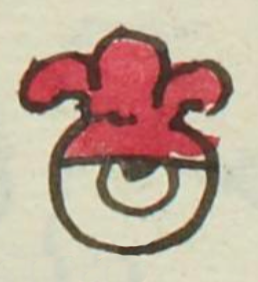Tlamauh (MH522r)
This simplex glyph for the personal name Tlamauh ("Wise One," or "Knowing One," attested here as a man's name) shows a frontal view of a starry or stellar eye with a red, tripartite design on top of the eye. It looks something like a jester's cap. The eyelid is its usual red, and what sits atop the eyelid is also red; they two almost seem seamless, although there is a half-line cutting across between them, from the left.
Stephanie Wood
Tlamah (or Tlamao, as it is often spelled) is a powerful name and a popular one. The style of this eye is also called the starry eye or stellar eye, given how it can double as a star in the sky. This connection with celestial phenomena may relate to the meaning of the personal name. From other examples we also see a connection with Ehecatl. The name seems to derive from tlahmati, supposedly to "practice trickery or sorcery" (very close to tlamati, to know something). However, the translation of sorcery and trickery reveals a Christian bias on the part of the friar Alonso de Molina, and really the Nahuas saw the Tlamao as being wise, perhaps like a priest or a tlamatini. Supporting this, the use of the eye (ixtli) for the glyph calls forth the verb ixtlamati, to be wise, prudent. Furthermore, Marc Thouvenot (2010, 178–181) explains how iximati (which can become imati, to manage cleverly or create skillfully) compares to mati (to know). Imati involves knowing through seeing, much like conocer might indicate in Spanish, and mati is "to know" as in saber in Spanish. Once again, then, the eye glyph is a semantic indicator for a place of wisdom.
Stephanie Wood
pedro tlamaho
Pedro Tlamauh (or Pedro Tlamao)
Stephanie Wood
1560
José Aguayo-Barragan, Stephanie Wood
wisdom, sabiduría, knowledge, conocimiento, educación, education, eyes, ojos, stars, estrellas, nombres de hombres

tlamauh, wise one, knowledgeable person, or possibly sorcerer, https://nahuatl.wired-humanities.org/content/tlamauh
tlamauh(tli), crazed, berzerk, or infected, https://nahuatl.wired-humanities.org/content/tlamauhtli
ix(tli), eye, https://nahuatl.wired-humanities.org/content/ixtli
ixtlamati, to be wise, prudent, https://nahuatl.wired-humanities.org/content/ixtlamati
tlamati, to know something, or to know sacred powers (verb), https://nahuatl.wired-humanities.org/content/tlamati
tlamatini, a sage, wise person, scholar, https://nahuatl.wired-humanities.org/content/tlamatini
tlama, someone knowledgeable, also a medico, https://nahuatl.wired-humanities.org/content/tlama-0
El Sabio
Stephanie Wood
Matrícula de Huexotzinco, folio 522r, World Digital Library. https://www.loc.gov/resource/gdcwdl.wdl_15282/?sp=183&st=image
This manuscript is hosted by the Library of Congress and the World Digital Library; used here with the Creative Commons, “Attribution-NonCommercial-ShareAlike 3.0 License” (CC-BY-NC-SAq 3.0).










